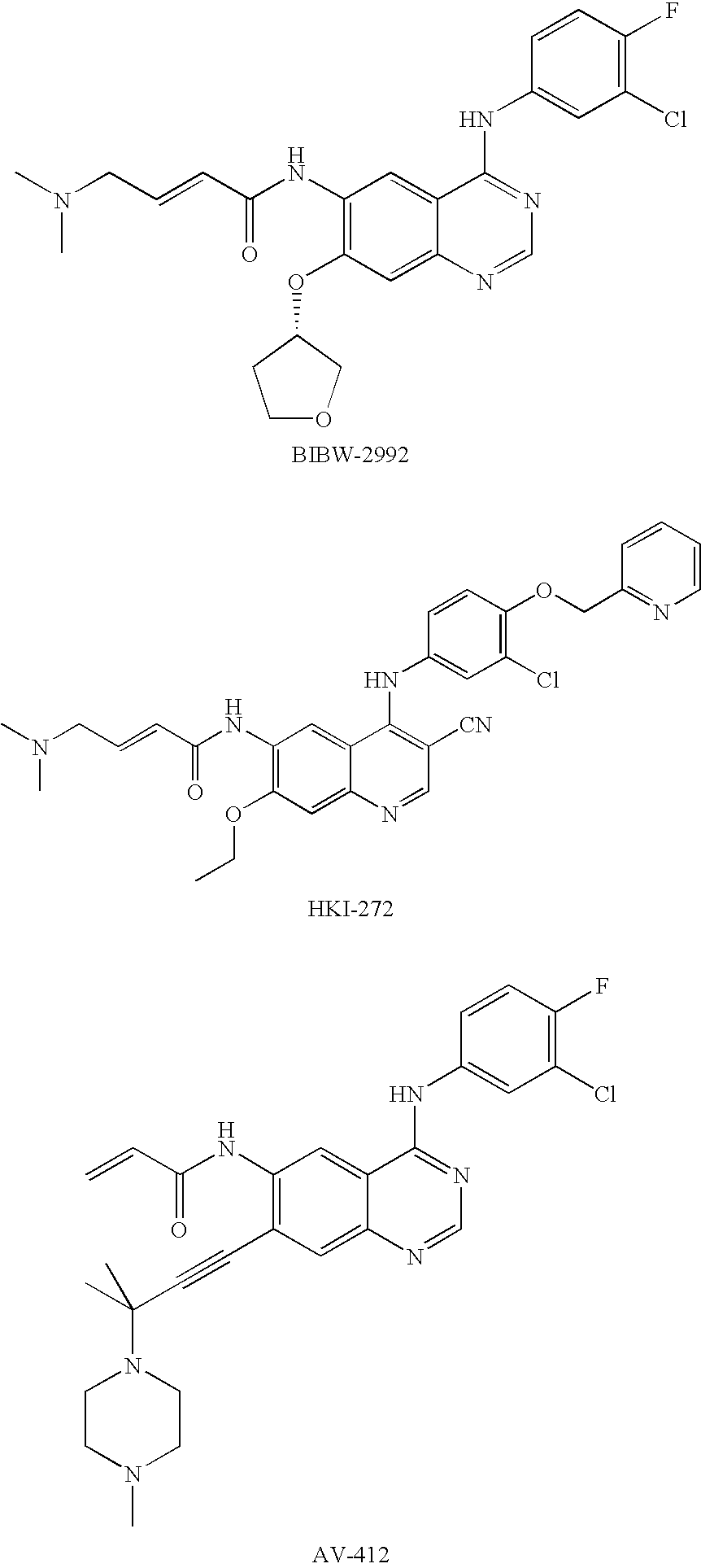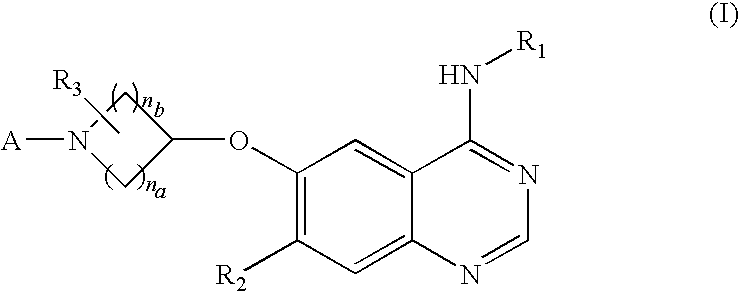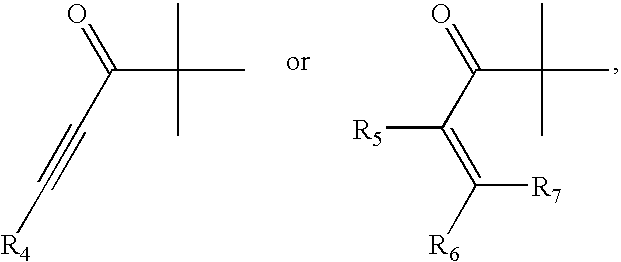Novel amide derivative for inhibiting the growth of cancer cells
- Summary
- Abstract
- Description
- Claims
- Application Information
AI Technical Summary
Benefits of technology
Problems solved by technology
Method used
Image
Examples
example 1
Preparation of 1-((3S)-3-(4-(3-chloro-2,4-difluorophenylamino)-7-methoxyquinazolin-6-yloxy)pyrrolidin-1-yl)pro-2-pen-1-one
(1-1) 6,7-dimethoxyquinazolin-4(3H)-one
[0182]36.9 g of 4,5-dimethoxyanthranilic acid was mixed with 25.0 g of formamidine hydrochloride, and the mixture was stirred at 210° C. for 30 minutes. After completion of the reaction, the solid thus obtained was cooled to room temperature, stirred with 200 ml (0.33 M) of aqueous sodium hydroxide and filtered under a reduced pressure. The solid thus obtained was washed with water and air-dried to obtain the title compound (24.6 g, 64%).
[0183]1H-NMR (300 MHz, DMSO-d6) δ 7.99 (s, 1H), 7.44 (s, 1H), 7.13 (s, 1H), 3.90 (s, 3H), 3.87 (s, 3H).
(1-2) 6-hydroxy-7-methoxyquinazolin-4(3H)-one
[0184]3.06 g of the compound obtained in (1-1) was diluted with 20 ml of methanesulfonic acid. 2.66 g of L-methionine was added to the resulting solution and stirred at 100° C. for 22 hours. Ice was added to the reaction mixture and neutralized w...
example 2
Preparation of (E)-1-((3S)-3-(4-(3-chloro-2,4-difluorophenylamino)-7-methoxyquinazolin-6-yloxy)pyrrolidin-1-yl)but-2-en-1-one
[0198]The procedure of Example 1 was repeated except for using trans-crotonyl chloride instead of acryloyl chloride in step (1-7) to obtain the title compound (35 mg, 60%).
[0199]1H-NMR (300 MHz, CDCl3) δ 8.53 (s, 1H), 7.74 (m, 1H), 7.37 (s, 1H), 7.14 (s, 1H), 7.03 (m, 1H), 6.86 (m, 1H), 5.99 (m, 1H), 5.11 (bm, 1H), 4.09 (s, 1H), 3.94 (s, 3H), 3.81 (m, 4H), 2.46 (m, 1H), 2.29 (m, 1H), 1.83 (m, 3H);
[0200]MS (ESI+): m / z=475.2 [M+H]+.
example 3
Preparation of 1-((3S)-3-(4-(3-chloro-2,4-difluorophenylamino)-7-methoxyquinazolin-6-yloxy)pyrrolidin-1-yl)but-2-yn-1-one
[0201]The procedure of Example 1 was repeated except for using but-2-inoyl chloride instead of acryloyl chloride in step (1-7) to obtain the title compound (50 mg, 46%).
[0202]1H-NMR (300 MHz, CDCl3) δ 8.58 (s, 1H), 7.88 (m, 1H), 7.37 (s, 1H), 7.20 (s, 1H), 7.04 (t, 1H), 5.14 (bm, 1H), 3.98 (s, 3H), 3.82 (m, 4H), 2.39 (m, 1H), 2.27 (m, 1H), 1.92 (s, 3H);
[0203]MS (ESI+): m / z=473.1 [M+H]+.
PUM
| Property | Measurement | Unit |
|---|---|---|
| Electrical resistance | aaaaa | aaaaa |
Abstract
Description
Claims
Application Information
 Login to View More
Login to View More - Generate Ideas
- Intellectual Property
- Life Sciences
- Materials
- Tech Scout
- Unparalleled Data Quality
- Higher Quality Content
- 60% Fewer Hallucinations
Browse by: Latest US Patents, China's latest patents, Technical Efficacy Thesaurus, Application Domain, Technology Topic, Popular Technical Reports.
© 2025 PatSnap. All rights reserved.Legal|Privacy policy|Modern Slavery Act Transparency Statement|Sitemap|About US| Contact US: help@patsnap.com



